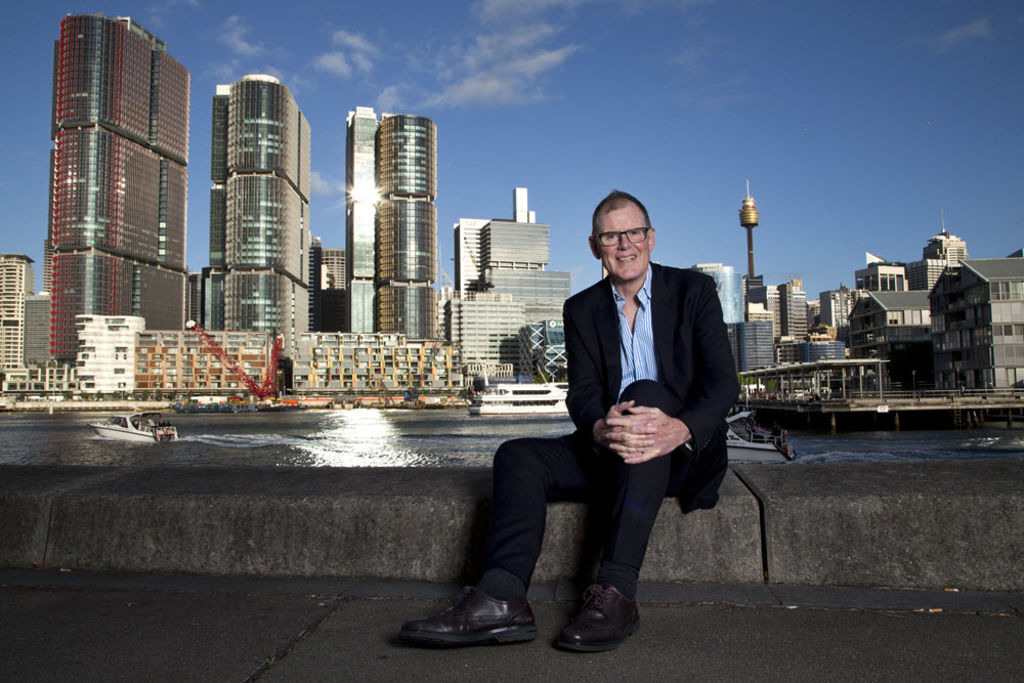
Rob Harley: Lessons from a life in property
In February 1988, I joined the The Australian Financial Review as a young property writer. The cities were full of cranes building office towers underpinned by the seemingly inexorable growth of financial deregulation and the supposedly inexhaustible finance from the Japanese miracle. In the suburbs, house prices were about to rocket as the Reserve Bank of Australia cut rates in the wake of 1987 share price crash.
This week I left The AFR after near 29 years with a ringside seat of Australian property. In those years the cities have been remade, 4.5 million new homes have been built; property investment has surged; commercial property has busted twice, and housing has been through three cycles of surge and pause.
Today, cranes once again rise against the city skyline, this time building apartments for the seemingly implacable rationale of housing undersupply and the supposedly inexhaustible demand of Asian investors. In the suburbs, prices have soared, in Sydney up by 60 per cent in four years, but well short of the supercharged doubling of price in one year, seen in 1988.
For a journalist, it is the dramas of those years that stand out. The battle for Hooker Corporation in the 1980s and early 1990s; the turmoil over the development of Sydney’s East Circular Quay; the fall of Lendlease and its reconstruction under Steve McCann. Then there were the battles for the GPT Group and the AMP real estate trusts in the 2000s; the near death experience of the global financial crisis, and most recently the fight over the restructure of Westfield Group in the 2000s.
 The battle for east circular quay was one of the defining events in Sydney property. Photo: Domino Postiglione
The battle for east circular quay was one of the defining events in Sydney property. Photo: Domino Postiglione
Just as important, property is not just prices and buildings and cycles and demographics. It’s the people who stand out. At one end the industry has its legends, like Westfield’s Frank Lowy, Mirvac’s Bob Hamilton, and Meriton’s Harry Triguboff. At the other end there are a never-ending dribble of spivs and spruikers preying on gullible consumers, investors, and sadly, politicians.
From all those years there are lessons.
House prices do go down
House prices do fall. Of course they do. Everyone now knows that prices fall in mining towns when the miners leave. They know that prices weaken in Perth when the big money evaporates. They even expect prices to fall in the over-supplied apartment sectors of Melbourne and Brisbane.
But over and over again I hear that blue-chip Sydney prices never fall. Well, they do. Around Sydney Harbour prices near halved in the early 1990s when the high-flying entrepreneurs who bid up the mansions were forced to sell out. Paradis Sur Mer, the waterfront home in Point Piper made famous by the late Susan Renouf, was bought for a then Sydney record of $19.2 million in 1988. In the early 1990s, it was sold for redevelopment at just $13 million.
 Paradis Sur Mer, the Point Piper mansion, was a victim of Sydney’s housing slump in the 1990s. Photo: Fairfax archive
Paradis Sur Mer, the Point Piper mansion, was a victim of Sydney’s housing slump in the 1990s. Photo: Fairfax archive
Commercial property more volatile than housing
In 1988 the latest office boom was in full swing. Alan Bond had just bought the site of Sydney’s Chifley Tower and was planning an even taller tower on Park Street, which was up the road. Rents had soared, fuelled by financial deregulation, and prices were being bid up by the Japanese and fast-growing, but fatally flawed, unlisted property trusts.
In February 1989, MEPC, one of the last of the great UK property companies to exit Australia, sold the 20 Bond Street tower in Sydney to the Armstrong Jones Growth Fund for $370 million on a yield of 5 per cent. It was one of those deals that marked the peak. Interest rates started to rise, office demand slowed, a mass of new office supply emerged as boom-time towers were finished, pushing vacancy close to 20 per cent, and the Japanese miracle evaporated. In the wake of the crash, Lendlease’s then chairman Stuart Hornery apologised to investors for missing the opportunity to sell Australia Square.
When rents fall, and yields rise, the impact on value is dramatic. In 2004, 15 years after the last transaction, a half share in 20 Bond Street sold, on a 6.95 per cent yield, for $136.2 million, well short of the price achieved 15 years before. (Global real estate group JLL kindly provided the data, and the graph of Sydney’s office rents and prices. Take care with the rent graph becauses the figure excludes lease incentives). Today, after several major refurbishments and environmental upgrades, and another dramatic tightening in yields, the half share in 20 Bond Street has a June 30 book value, on a yield of 5.54 per cent, of $251 million.
For a number of investors, office towers are a cyclical play. Buy low and sell high, and don’t hold long-term, is the mantra. Of course, it’s easier said than done. Because as the peak approaches, the buyers disappear. Billionaire Lang Walker sold a huge portfolio in 2006 but had to wait through 18 months of price rises before, in the wake of the global financial crisis, the sale looked inspired.
Filling the donut city
The collapse of the 1980s office boom, which pockmarked the CBD with empty building craters, proved pivotal in the renaissance of the city. For 70 years, from 1910, the Sydney CBD had been losing people and jobs. By the time I joined The AFR even the landmark department stores David Jones and Myer were considering an exit to the suburbs.
 By the 1980s, even stores such as David Jones were considering leaving the CBD. Photo Christopher Pearce
By the 1980s, even stores such as David Jones were considering leaving the CBD. Photo Christopher Pearce
But slowly, from a nadir in 1978, the city started to turn. As in Melbourne, the empty sites and cheap office towers provided an opportunity and a catalyst for a Frank Sartor-led city. Sartor was a former Sydney lord mayor. Apartment towers started to emerge and bit by bit Sydney’s population started to rise. The amenities followed and under mayor Clover Moore, inner-city shopping and tourism revived. Now, in what’s a global phenomenon, people want to live close to the city.
Inner-city employment is also on the rise, reinforced by the technology boom. Twenty years ago, in the first flush of digital business, the experts predicted the end of the CBD office and the rise of a mobile, dispersed workforce. Many do work externally, but so far, at a macro level, the opposite has happened. Tech heads want to work together and collaborate, reinforcing the primacy of locations from Silicon Valley to Shoreditch and in Sydney, the CBD.
Bad property hurts, bad finance is fatal
One Sunday in December 2007, I rang my contact at the Centro Property Group. Under Andrew Scott it had been one of the high flyers of the Real Estate Investment Trust (REIT ) boom. With a soaring share price, Scott had been an aggressive acquirer, most recently of a major US portfolio. But in the week before I rang, Centro had gone into trading halt as it attempted to refinance debt. “What is happening?” I asked. “‘I can’t talk now, but it’s bad,'” said my contact.
It was. Centro couldn’t refinance its short-term debt. The next day, the group was at the mercy of its bankers. Years of turmoil followed. Today, the properties are fine, core assets of Vicinity Centres in Australia and the Brixmor Property Group in the US. But investors lost all of their money except for 5 cents.
Too much debt, or too much exposure to rising interest rates, or the wrong debt covenants can be fatal.
Irwin Graf, the legendary founder of what is now Stockland, reminisced with me before he stepped down as chairman in 2000. He remembered the day, 26 years earlier, that he had locked in his interest rates. If not, Stockland would have gone the same way as the long forgotten developers of the 1970s like Parkes, Cambridge Credit and Home Unit Headquarters.
In the same debt tempest of the early 1970s, Meriton founder Harry Triguboff chased down his funders in the US, struck a deal that delivered more than foreclosure, and emerged with the foundations of a business that would make him Australia’s richest man.
 Harry Triguboff, the head of Meriton and the richest man in Australia. Photo: Louise Kennerley
Harry Triguboff, the head of Meriton and the richest man in Australia. Photo: Louise Kennerley
Bad debt is not only fatal to developers. Financiers suffer as well. The Reserve Bank has noted commercial property collapses have been far more dangerous in Australia than anything that has happened to housing. The bust of the early ’90s almost claimed Westpac Banking Corporation, and in the wake of the GFC, aggressive property lenders, Bankwest and St George, ceased to exist as separate entities.
REIT reckoning
Centro was the canary in the Real Estate Investment Trust coalmine. Within 18 months, the sector that had soared through the early 2000s was brought to earth, as the banks demanded the money back, and, with nowhere else to turn, the REITs had to raise equity through deeply discounted raisings.
In the furore, the logistics property giant Goodman Group lost more than 90 per cent of its value. As the price plunged, founder and chief executive Greg Goodman called me in to explain how the group would be recapitalised, with help from China Investment Corporation and Macquarie Group. The plan worked. Goodman remerged with a business now worth $11 billion, but a determination never to be at the mercy of debt or bankers again.
Value in houses
For a man who has made billions in logistics property, Goodman has a strong penchant for Sydney homes. Which should not surprise. With population and economic growth, tight supply, attractive tax benefits and a 30-year decline in interest rates, Sydney homes have proved a remarkably good investment. When I joined The AFR, the median house price in the city had just passed $100,000, according to global real estate analytics group, CoreLogic. As I leave, the figure is $890,000. Sure the yields have been low but so has been the volatility. On the CoreLogic numbers, the biggest fall in capital city dwelling values was in a drop of 5.3 per cent in the year to May 2012, preceding the current boom.
Housing investment becomes mainstream
The performance of housing has turned the sector into a mum and dad investment class. In the 12 months to September 1986, investment lending totalled $1.7 billion, or 13 per cent of total dwelling finance. Thirty years later, in the year to September 2016, investors borrowed $137.5 billion, or 35 per cent of the total housing finance.
Of course, all investment soared in those years, helped by compulsory superannuation. In 1988, the Property Council Investment Performance Index counted $17.8 billion of office towers and shopping centres. Today, the Property Council/IPD Index includes $158 billion of commercial real estate. One day, affordable or social housing will likely become an institutional grade class of real estate investment.
However much property values rise, government charges will rise further.
In 1988, the stamp duty on an average priced house in Sydney was $1304. Today, due to the NSW government’s refusal to change key thresholds, the stamp duty is $40,490 and even more, $80,490 for foreign buyers. If house prices have risen 10 times, the government take has soared by a factor of 40. In a world where so many other tax bases are portable, property is a sitting target. Increased taxes on property are inevitable. The sensible sounding “value capture” is just the latest way of skinning the sector.
 Frank Lowy (centre) with sons Steven and Peter inspecting construction at the new Westfield site on Pitt Street, Sydney, in 2010. Photo: Louie Douvis
Frank Lowy (centre) with sons Steven and Peter inspecting construction at the new Westfield site on Pitt Street, Sydney, in 2010. Photo: Louie Douvis
Frank Lowy
For me, it’s the people who have made property reporting, and the standout for my years of writing has been Westfield co-founder Frank Lowy. Many developers built shopping centres but Lowy was one of the few who recognised the value not just in developing but in holding and managing. And he’s the only one to have created a shopping centre brand – an Australian brand now a household word in London and much of the US. Last week, we had coffee. For a man who has mastered so many complexities he can also make real estate very simple. Successful property, he said, is that which “people want and can use”.











